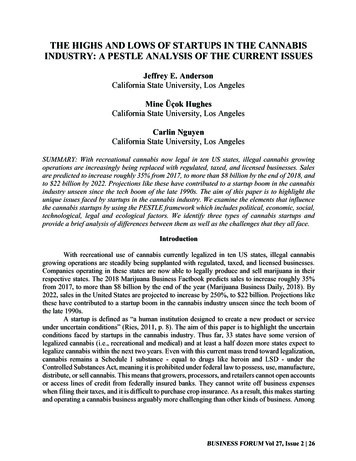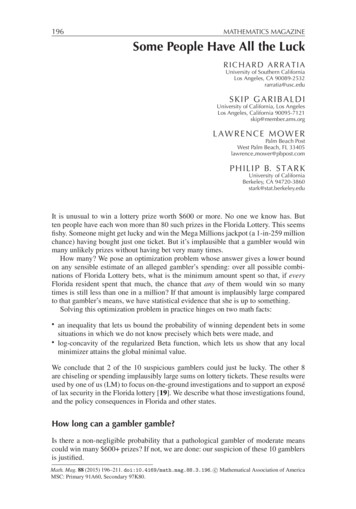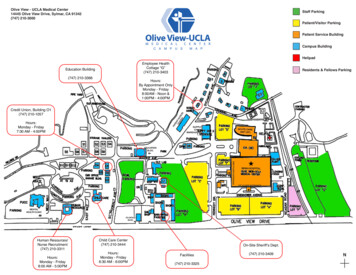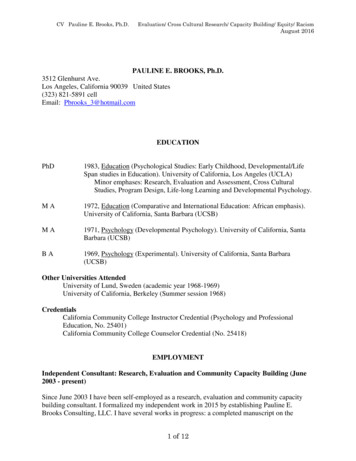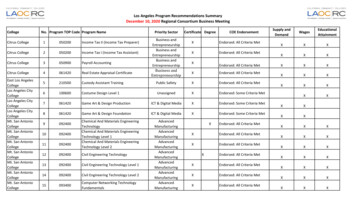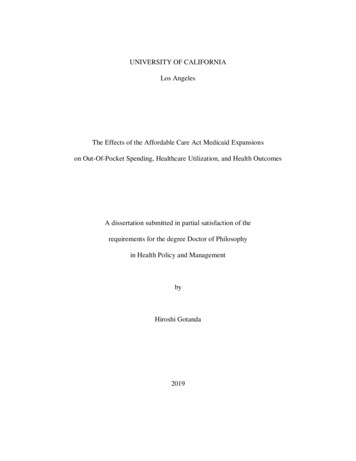
Transcription
UNIVERSITY OF CALIFORNIALos AngelesThe Effects of the Affordable Care Act Medicaid Expansionson Out-Of-Pocket Spending, Healthcare Utilization, and Health OutcomesA dissertation submitted in partial satisfaction of therequirements for the degree Doctor of Philosophyin Health Policy and ManagementbyHiroshi Gotanda2019
Copyright byHiroshi Gotanda2019
ABSTRACT OF THE DISSERTATIONThe Effects of the Affordable Care Act Medicaid Expansionson Out-Of-Pocket Spending, Healthcare Utilization, and Health OutcomesbyHiroshi GotandaDoctor of Philosophy in Health Policy and ManagementUniversity of California, Los Angeles, 2019Professor Gerald F. Kominski, ChairIt is well documented that lack of health insurance negatively affects access to care and healthoutcomes. Uninsured people are less likely, compared to those with health insurance, to haveusual source of care and receive necessary care primarily due to the cost, leading to detrimentalhealth consequences. The Medicaid expansions under the Patient Protection and Affordable CareAct (ACA) were intended to provide access to health insurance coverage for many of the morethan 45 million uninsured Americans. This major policy change originally required all states toexpand the eligibility of their Medicaid programs to those younger than 65 years with incomesup to 138% of the federal poverty level (FPL), based solely on income without regard tocategorical eligibility status. To date, there is ample evidence that the percentage of theuninsured has been significantly reduced nationally despite the fact that 14 states have notii
adopted the ACA Medicaid expansions as of August 2019 due to the 2012 Supreme Court rulingmaking those expansions voluntary rather than mandatory.This dissertation assessed the further effects of the ACA Medicaid expansions on out-of-pocketspending, healthcare utilization, and health outcomes for chronic conditions using a nationallyrepresentative sample of the low-income non-elderly population from the 2010-2016 MedicalExpenditure Panel Survey and 2005-2016 National Health and Nutrition Examination Survey. Ittook advantage of the natural experiment that allowed a comparison of changes in outcomesbetween the expansion and non-expansion states. The three studies found that the ACA Medicaidexpansions were associated with reduced out-of-pocket spending and improved financial riskprotection, a modest increase in primary care physician visits without any meaningful change inemergency department visits, and improved clinical measures for hypertension and diabetes (butno improvement in outcomes for hyperlipidemia and depression), during the three years after thepolicy implementation.The findings suggest that the ACA has been successful in achieving its goals of removingfinancial barriers, promoting access to primary care, and improving population health amonglow-income uninsured Americans. It has important implications for state decisions on adoptingthe ACA Medicaid expansions and for the ongoing national debate over the repeal of the ACA,including the Medicaid expansions.iii
The dissertation of Hiroshi Gotanda is approved.Abdelmonem A. AfifiThomas H. RiceYusuke TsugawaGerald F. Kominski, Committee ChairUniversity of California, Los Angeles2019iv
TABLE OF CONTENTSChapter 1. Introduction .1Overview of the Dissertation .1The Uninsured .1ACA Medicaid Expansions .2Study Outcomes and Conceptual Framework .5Difference-in-differences approach .8Contribution to Health Policy and Health Services Research . 11References . 12Tables and Figures . 16Chapter 2. Out-of-Pocket Spending, Premium Contributions, and Catastrophic HealthSpending among Low-Income Families during the First 3 Years of the ACAMedicaid Expansions (Paper #1) . 19Abstract . 19Background . 20Methods . 21Results . 30Discussion . 33References . 37Tables and Figures . 42Chapter 3. Association between the ACA Medicaid Expansions and EmergencyDepartment and Primary Care Use during the First 3 Years (Paper #2) . 53Abstract . 53Background . 54Methods . 55v
Results . 62Discussion . 63References . 67Tables and Figures . 71Chapter 4. Association between the ACA Medicaid Expansions and Health Outcomesfor Hypertension, Diabetes, Hyperlipidemia, and Depression (Paper #3) . 81Abstract . 81Background . 82Methods . 83Results . 93Discussion . 96References . 100Tables and Figures . 105Chapter 5. Conclusions . 1205-1.Summary of Key Findings . 1205-2.Implications for Policy . 1215-3.Future research directions . 1225-4.References . 125vi
LIST OF FIGURESFigure 1-A. Conceptual Framework . 18Figure 2-A. Flow diagram of the study population . 49Figure 2-B. Unadjusted yearly trend in spending outcomes by ACA Medicaid expansionstatus . 50Figure 2-C. Unadjusted yearly trend in catastrophic health spending by ACA Medicaidexpansion status. 51Figure 2-D. Unadjusted yearly trends in insurance coverage by ACA Medicaid expansionstatus . 52Figure 3-A. Flow diagram of the study population . 78Figure 3-B. Unadjusted yearly trends in PCP use by ACA Medicaid expansion . 79Figure 3-C. Unadjusted yearly trends in ED use by ACA Medicaid expansion status . 80Figure 4-A. Flowchart of the study population . 114Figure 4-B. Unadjusted yearly trend of blood pressures by ACA Medicaid expansionstatus . 115Figure 4-C. Unadjusted yearly trend of hemoglobin A1c by ACA Medicaid expansionstatus . 116Figure 4-D. Unadjusted yearly trend of cholesterol levels by ACA Medicaid expansionstatus . 117Figure 4-E. Unadjusted yearly trend of other outcomes by ACA Medicaid expansionstatus . 118vii
LIST OF TABLESTable 1-A. Status of state decisions on the ACA Medicaid expansions as of August 2019. 16Table 1-B. Trend of uninsured nonelderly adults (18-64 years old) by poverty level . 17Table 2-A. Definition of expansion states and pre- and post-expansion periods. 42Table 2-B. Baseline characteristics of family’s reference persons by ACA Medicaidexpansion status . 43Table 2-C. Test of parallel trend assumption . 44Table 2-D. Change in spending and financial burden outcomes following ACA Medicaidexpansions . 45Table 2-E. Change in insurance coverage following ACA Medicaid expansionsa . 46Table 2-F. Sensitivity analyses using alternate sample definitions . 47Table 2-G. Sensitivity analysis using alternate model specifications . 48Table 3-A. Definition of expansion states and expansion period . 71Table 3-B. Baseline characteristics of participants by ACA Medicaid expansion status . 72Table 3-C. Association between ACA Medicaid expansions and insurance coverage . 73Table 3-D. Test for parallel trend assumption . 74Table 3-E. Association between ACA Medicaid expansions and emergency departmentand primary care use . 75Table 3-F. Sensitivity analysis using alternate sample definitions . 76Table 3-G. Sensitivity analysis using alternate model specifications . 77Table 4-A. Definitions of expansion states and expansion periods . 105Table 4-B. Baseline characteristics of participants by ACA Medicaid Expansion status. 106Table 4-C. Test of parallel trend assumption . 107viii
Table 4-D. Change in health outcomes following ACA Medicaid expansions . 108Table 4-E. Sensitivity analyses using alternative sample definitions (hypertension anddiabetes-related outcomes) . 110Table 4-F. Sensitivity analyses using alternative sample definitions (hyperlipidemia anddepression-related outcomes) . 112ix
ACKNOWLEDGMENTSThis work was supported by the VA Advanced Fellowship in Geriatrics and UCLA GraduateDivision Award. The views expressed in this dissertation are those of the author and do notnecessarily reflect the position or policy of the Department of Veterans Affairs or the UnitedStates government.Paper #1 of this dissertation is a version of the following manuscript:Gotanda H, Kominski G, Tsugawa Y. Association between the ACA Medicaid Expansions andPrimary Care and Emergency Department Use during the First 3 Years (Revised andResubmitted at Journal of General Internal Medicine)In Paper #1, author contributions were as follows: All authors conceived and designed the study.HG performed the statistical analyses and data management. HG and YT drafted the initialmanuscript. All authors interpreted the data, revised the manuscript critically, and approved thefinal manuscript.Paper #2 of this dissertation is a version of the following manuscript:Gotanda H, Jha AK, Kominski G, Tsugawa Y. Out-of-Pocket Spending and Financial Burdenamong Low-Income Adults during the First 3 Years of the ACA Medicaid Expansions: A QuasiExperimental Study (under submission)x
In Paper #2, author contributions were as follows: HG, GK, and YT conceived and designed thestudy. HG performed the statistical analyses and data management. HG and YT drafted the initialmanuscript. All authors interpreted the data, revised the manuscript critically, and approved thefinal manuscript.xi
VITAEDUCATION & TRAININGAdvanced FellowVA Advanced Fellowship in GeriatricsJul 2016 – Jun 2019VA Greater Los Angeles, Los Angeles, CA.FellowGeriatric Medicine FellowshipJul 2015 – Jun 2016UCLA/VA Greater Los Angles, Los Angeles, CA.ResidentJul 2012 – Jun 2015Internal Medicine ResidencyMount Sinai Beth Israel, New York, NY.Fellow (Japan)Internal Medicine/Geriatric Medicine FellowshipApr 2008 – Mar 2011The University of Tokyo Hospital, Tokyo, Japan.Resident (Japan)Postgraduate Medical Education ProgramApr 2006 – Mar 2008Asahi General Hospital, Chiba, Japan.Doctor of Medicine The University of Tokyo School of MedicineApr 2000 – Mar 2006Tokyo, Japan.PROFESSIONAL EXPERIENCEClinical InstructorApr 2011 – Jun 2012Department of GeriatricsThe University of Tokyo Hospital, Tokyo, Japan.PUBLICATIONS1.Gotanda, H., Ganz, D. A., & Wenger, N. S. (2018). Association between Estimated Mortality Riskand Measured Quality of Care in Older Adults. J Am Geriatr Soc, 66(9), 1838-1844.2.Gotanda, H., Fogel, J., Husk, G., Levine, J. M., Peterson, M., Baumlin, K., & Habboushe, J. (2015).Hurricane Sandy: Impact on Emergency Department and Hospital Utilization by Older Adults inLower Manhattan, New York (USA). Prehosp Disaster Med, 30(5), 496-502.3.Gotanda, H., Kameyama, Y., Yamaguchi, Y., Ishii, M., Hanaoka, Y., Yamamoto, H., Ogawa, S.,Iijima, K., Akishita, M., & Ouchi, Y. (2013). Acute exogenous lipoid pneumonia caused byaccidental kerosene ingestion in an elderly patient with dementia: a case report. Geriatr Gerontol Int,13(1), 222-225.xii
Chapter 1.IntroductionOverview of the DissertationThis three-paper dissertation evaluates the impact of the Medicaid expansions in 2014 under thePatient Protection and Affordable Care Act (ACA) that primarily aimed to reduce the number ofuninsured low-income Americans by providing affordable health insurance. Among a widevariety of outcomes, the three studies in this dissertation examine the effects of the ACAMedicaid expansions on the following:(i) Out-of-pocket spending, premium contribution spending, out-of-pocket plus premiumcontribution spending, and catastrophic spending (paper #1);(ii) Primary care physician and emergency department visits (paper #2); and(iii) Health outcomes for hypertension, diabetes, hyperlipidemia, and depression (paper #3).This first chapter introduces the background of the uninsured, ACA Medicaid expansions, theconceptual framework underlying the three studies of this dissertation, and the contributions ofthese studies to health policy and health services research. The second, third, fourth chapterspresent papers #1, #2, and #3, respectively. The fifth chapter provides conclusions from thedissertation.The UninsuredThe proportion of the population without health insurance in the U.S. has been higher than othercomparable countries despite the fact that the U.S. spends substantially more on healthcare. 1,2 In1
2010, 46.5 million nonelderly individuals (ages 0-64)—approximately 18% of that age group—lacked health insurance coverage.3,4 Young adults, minorities, and low-income populations weremost likely to be uninsured.3,4It is well documented that lack of health insurance negatively affects access to care and healthoutcomes. Half of the uninsured non-elderly adults do not have a usual source of care when theyare sick or need medical advice.4 Uninsured people are less likely, compared to those with healthinsurance, to receive recommended preventive care and treatments for chronic conditions,primarily because of the cost of care.4-6 As a result, they are more likely to experiencedetrimental health consequences such as diagnoses at later stages of diseases including cancerand higher mortality rates.7,8The uninsured frequently face financial hardship as well. They are far more likely than theirinsured counterparts to have a problem paying medical bills or to be unable to pay medical bills.4The negative consequences of medical bills include cutting back spending on food, clothing, orbasic household items, depleting savings, and having medical bills sent to collection agencies.9They are also at high risk of financial catastrophe, especially in the event of emergency medicalsituations.10ACA Medicaid ExpansionsThe Patient Protection and Affordable Care Act (ACA) was signed in by President BarackObama on March 23, 2010, which brought the most significant changes to the U.S. healthcaresystem since Medicare was established in 1965. One of the primary purposes of the ACA was to2
expand access to health insurance coverage for the vast majority of uninsured Americans,particularly among the population with low- and moderate family incomes.11,12 This majortransformation was based on the concept that healthcare is a right, rather than a privilege. 13The ACA employed two approaches to achieve its goal. First, it required all states to expand theeligibility of their Medicaid programs to those younger than 65 years with incomes up to 138%of the federal poverty level (FPL) ( 16,753 for individuals in 2018), based solely on incomewithout regard to categorical eligibility status for groups such as parents, pregnant women, andindividuals with disabilities.12,14,15 Second, it created Health Insurance Marketplaces (also knownas Exchanges)—organized and competitive markets for buying health insurance—through whichpremium and cost-sharing subsidies are available for those with incomes up to 400% of FPL( 48,560 for individuals in 2018).12,15,16 Because these two approaches are quite different, thisdissertation focuses on the ACA Medicaid expansions, which target the most vulnerablepopulation financially, medically, and socially, consisting of a majority of the uninsured in theU.S.17The ACA Medicaid expansions were originally mandated for all states. The 2012 Supreme Courtruling on the ACA, however, made the Medicaid expansion essentially optional for states. 12Consequently, 14 states still have not adopted the ACA Medicaid expansions as of August 2019while 37 states including District of Columbia (D.C.) (hereafter referred to as a state for brevity)adopted the ACA Medicaid expansions (Table 1-A).18 This dissertation takes advantage of thisrare opportunity brought by the 2012 Supreme Court ruling that enabled us to examine the3
effects of this policy intervention by comparing changes in outcomes in expansion and nonexpansion states.It is important to note that there are several subgroups among those states that have adopted theACA Medicaid expansions as of May 2019 (Table 1-A):(i) 6 states (California, Connecticut, D.C., Minnesota, New Jersey, and Washington) thathave expanded Medicaid to low-income adults through the ACA State PlanAmendment and/or Section 1115 Waiver authority in 2010 to 2011 to prepare for themain implementation in 2014; although the magnitude of expansion was notsubstantial in New Jersey and Washington;19,20(ii) 19 states that implemented ACA Medicaid expansions on January 1, 2014;(iii) 9 states that implemented ACA Medicaid expansions after January 1, 2014;(iv) 3 states (Idaho, Nebraska, and Utah) that adopted ACA Medicaid expansions buthave not yet implemented;18(v) 8 states that have approved Section 1115 Waivers for ACA Medicaid expansions;18(vi) 5 states (Delaware, Hawaii, Massachusetts, New York, and Vermont) that hadalready provided Medicaid or similar coverage to adults with family incomes up to atleast 100% of the FPL prior to 2014;19,21 and(vii) Wisconsin, which started comprehensive insurance coverage for childless adultswith family incomes up to 100% of FPL through a non-Medicaid program as ofJanuary 1, 2014.224
There is ample evidence that the percentage of the uninsured significantly reduced nationallysince the implementation of the ACA Medicaid expansions and that these reductions in theexpansion states significantly exceed those in the non-expansion states (Table 1-B).12,23 Thereductions in the share of the uninsured in the expansion states seem to be attributable to gains innew Medicaid coverage as intended.23Study Outcomes and Conceptual FrameworkWhile early evaluations of the ACA Medicaid expansions have examined various outcomes inaddition to the share of uninsured, there are still knowledge gaps that need to be addressed. Thisdissertation particularly investigates the impact of Medicaid expansions, comparing expansionvs. non-expansion states, on the following outcomes among the low-income non-elderlypopulation:(i) Out-of-pocket spending, premium contribution spending, out-of-pocket plus premiumcontribution spending, and catastrophic spending (paper #1);(ii) Primary care physician and emergency department visits (paper #2); and(iii) Health outcomes for hypertension, diabetes, hyperlipidemia, and depression (paper #3).This section discusses the conceptual framework underlying these three study outcomes. Theliterature surrounding these outcomes will be detailed in the following chapters.Figure 1-A, a conceptual model adapted from Anderson behavioral model,24 depicts expecteddownstream effects of the ACA Medicaid expansions. Arrows indicated hypothesized directionsof effects. Positive and negative signs indicate positive and negative associations, respectively,while arrows without signs indicate that the association could be positive or negative. The first5
row includes the independent variable (i.e., the ACA Medicaid expansions) and the maindependent variables. The second row includes unmeasured variables (except income) that arehypothesized to be directly related to dependent variables. The third row includes controlvariables that are hypothesized to be related to dependent variables through unmeasuredvariables in the second row. Although individual- and neighborhood-level characteristics havecomplicated interrelationships, this conceptual model is simplified for the sake of conciseness.(i) Out-of-pocket spending, premium contribution spending, out-of-pocket plus premiumcontribution spending, and catastrophic spending (paper #1):As discussed in the previous section, it has been demonstrated that the ACA Medicaidexpansions were associated with a reduction in the share of uninsured and an increase in theshare of Medicaid enrollees in the expansion states. It is hypothesized that Medicaid coverage forpreviously uninsured people following the ACA Medicaid expansions results in less out-ofpocket spending for health services (such as deductibles, copayment, and co-insurance) becausethe cost-sharing for Medicaid is very low or zero.25 It should also protect them from financialcatastrophe in the event of emergency medical conditions. Premium contributions should notincrease by obtaining Medicaid coverage as Medicaid generally charges no premiums.25 Inaddition, if there were offsetting decreases in the share of private health insurance following theACA Medicaid expansion (i.e., “crowd-out effect”), premium contributions should decrease onaverage among this population. The results of the empirical examination of these outcomes(paper #1) are presented in Chapter 2.6
(ii) Primary care physician and emergency department visits (paper #2)New Medicaid coverage is hypothesized to improve access to primary care providers in twoways. First, no or low cost-sharing for Medicaid coverage would promote primary care visits forthose who had postponed or forgone care because of the cost of care.4 Second, new Medicaidenrollees would no longer be turned down for care by primary care providers because they lackhealth insurance,26,27 which should increase the likelihood of having primary care visits.Emergency department (ED) visits could increase or decrease. Increased primary care visitswould be expected to improve health status, and therefore, the probability of visiting an ED ishypothesized to decrease. However, lower cost-sharing for Medicaid coverage might encouragethem to visit an ED more frequently. Having a primary care provider (as a result of newMedicaid coverage) could promote ED visits because of their referral to an ED as qualitativelydescribed in the analysis of the Oregon Health Insurance Experiment.28 The results of theempirical examination of these outcomes (paper #2) are presented in Chapter 3.(iii) Health outcomes for hypertension, diabetes, dyslipidemia, and depression (paper #3)Improved access to primary care providers is expected to increase the probability of receivingpreventive care and treatments of common chronic conditions, including hypertension, diabetes,hyperlipidemia, and depression. Therefore, population health for these conditions is expected toimprove in the expansion states. The results of the empirical examination of these outcomes(paper #3) are presented in Chapter 4.7
Difference-in-differences approachOne of the major goals of health policy research—including this dissertation—is to evaluate thecausal effects of policies and programs on various outcomes to help decide future priorities.While randomized controlled trials (RCTs) are typically considered the “gold standard” forcausal inference, large-scale RCTs are very rare in practice due to feasibility and ethical issues,and internal validity in RCTs often comes at the cost of external validity. Therefore, researchershave increasingly relied on quasi-experimental approaches, such as regression discontinuitydesign, instrumental variable method, propensity score matching, and difference-in-differences(DID) design, to estimate causal effects using observational data.29 Among these methods, thisdissertation employs DID models by taking advantage of an environment created by the SupremeCourt’s decision in 2012 to make the ACA Medicaid expansion optional for states.The DID design utilizes the control group (individuals living in non-expansion states) to estimatethe counterfactual outcomes of what would have happened to the treatment group (individualsliving in expansion states) in the absence of the treatment (i.e., ACA Medicaid expansions). Theeffects of the treatment can then be elicited without bias by contrasting the changes in outcomesover time between the treatment and control groups. Whereas the simplest form of the DIDdesign can only deal with the data with two groups (treatment and control groups) and twoperiods (pre- and post-treatment periods), the generalized form of the DID design canaccommodate multiple groups and multiple time periods and has been frequently used byresearchers in the field of policy evaluation. 19,21,29-31 This dissertation uses the generalized DIDto account for multiple states with various time-invariant characteristics and different timings ofMedicaid expansions as well as national secular trends in outcomes.8
The key assumption in the DID design is the parallel trends assumption. That is, the trends inoutcome variables should, without the treatment, be parallel between the treatment and controlgroups for the control group to serve as an appropriate counterfactual of the treatment group(although the treatment and control groups may have different levels of the outcome atbaseline).29 In assessing the validity of the parallel trends assumption, it is a common practice toexamine the trends in both groups during the pre-treatment period (because this cannot be testeddirectly in the post-treatment period) and to conclude that the assumption is plausible if there isno evidence of differential trends prior to the treatment. 19,21,29-32 This dissertation follows thispractice by comparing the trends in outcome variables between the expansion and non-expansionstates prior to the ACA Medicaid expansions.In health policy applications, however, it is not uncommon that the parallel trends assumptiondoes not hold, which leads to biased estimation of the causal effects. Below are possiblescenarios and potential solutions:(i)
Fellow Geriatric Medicine Fellowship Jul 2015 - Jun 2016 UCLA/VA Greater Los Angles, Los Angeles, CA. Resident Internal Medicine Residency Jul 2012 - Jun 2015 Mount Sinai Beth Israel, New York, NY. Fellow (Japan) Internal Medicine/Geriatric Medicine Fellowship Apr 2008 - Mar 2011 The University of Tokyo Hospital, Tokyo, Japan.

